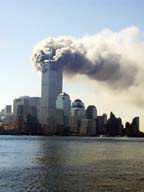More than a year has passed since the terrorist attacks destroyed both towers of the World Trade Center on Sept. 11. In that time, questions have been raised on the effects of smoke and dust from Ground Zero on commuters from the Hudson County area who travel to New York City for work.
A forum sponsored by the Environmental and Occupational Health Sciences Institute (EOHSI) and the University of Medicine and Dentistry of New Jersey (UMDNJ) addressing these concerns will be held Tuesday, Dec. 10 at the Jersey City Museum located at 350 Montgomery St. The forum will feature speakers from both organizations and will run from 6:30 to 8:30 p.m.
“One of the major factors in health concerns for New Jersey and New York commuters is dust from the WTC collapse,” said Dr. Michael Gallo, a toxicologist with EOHSI, who will speak at the Tuesday night meeting.
Gallo explained the dust that was kicked when the Twin Towers collapsed after being struck by the jet airliners is a health concern because of a large glass content.
“There was a lot of glass used in the construction of the towers,” Gallo said. “When the dust was tested, thin, needle-like fragments of glass were found.”
Also discovered in the dust was clay from the sheet rock in the walls and fiber from assorted building materials, Gallo added.
“When the towers fell, the wind blew the smoke and debris toward Brooklyn,” Gallo stated. “After two days, the winds changed and the smoke got carried over the Hudson River to the Jersey City area.”
Two surprises occurred when health officials tested the smoke both in Brooklyn and Jersey City a few days after the 9/11 disaster, according to Gallo.
“There was a large amount of lead in the smoke,” Gallo stated. “The lead was used to prevent corrosion in the metal beams of the Towers. In the fire, the lead paint was evaporated from the beams and mixed with the debris.”
The second surprise was the small amount of asbestos found in the air on the Jersey side of the Hudson River after the disaster.
“There was nothing across the river above the background level of asbestos,” Gallo said. “It appears asbestos was used only on the first 24 floors of the first tower. After that, asbestos was banned as a fire deterrent.”
Gallo added that the while the smoke from the World Trade Center contained a great deal of lead, test taken in Hudson County in the days after the 9/11 attacks showed very small amounts of lead in the air.
“The lead levels did not exceed Environmental Protection Agency safety levels,” Gallo said, adding that it was likely the lead dissipated with the smoke.
Gallo noted there was also high level of hydrocarbons in the WTC smoke, due for the most part from the jet fuel which ignited when the jets crashed into the towers.
“There was a huge tank of freon in the basement of Tower Two,” Gallo added. “Freon is a light gas, so when the tank exploded, the freon evaporated. If the tank had exploded earlier than it did, it could have acted as a fire retardant.”
The Dec. 10 forum is the third sponsored by EOSHI and UMDNJ, according to Jerry Carey, a UMDNJ spokes person.
“We had two other forums on health concerns earlier this year in lower Manhattan,” Carey explained. “There were questions about the effects on commuters from outside New York at those meetings, so we decided to have one in New Jersey.”
Also at the meeting will be representatives from the New Jersey Department of Health and Senior Services, Jersey City Medical Center, and the Hoboken Health Department. They will discuss lessons learned from the 9/11 attacks, according to Carey.
“Also featured in the program are speakers from Project Liberty,” Carey added. “Project Liberty is a free crisis counseling service for individuals, families and groups effected by the World Trade Center disaster.”
Besides providing Jersey City-area commuters with information on the health effects of smoke and debris generated by the Sept. 11 attacks, the forum hopes to reach out to non-New York City firefighters who helped with post-attack clean-up.
“Firefighters and others who were near Ground Zero after the attack have developed something called ‘WTC cough’,” said Gallo. “It’s a dry, hacking cough, which is a result of not wearing a mask or respirator while working in the ruins of the Trade Center.”
Gallo said the cough stems from lower and upper respiratory infections resulting from the inhalation of dust. Commuters who were in the area of lower Manhattan the days after the attack are also subject to developing the WTC cough.
“What we would like commuters from outside the New York area to do is reach out to their fire departments to see if any of their personnel were at the WTC fighting the fire,” Gallo said. “A lot of emergency personal rushed to the Trade Center and they may have caught the cough also.”
Gallo suggested that anyone who was near the World Trade Center during or after the terrorist attack who shows symptoms of the WTC cough should contact their doctor immediately.
“The cough is treated with medicine, and eventually the body expels the infection,” Gallo said. If the cough persists, Gallo added, a more thorough medical examine maybe needed.
For more information on the forum, call UMDNJ School of Public Health at (732) 445-0220. The UMDNJ website is www.umdnj.edu.
